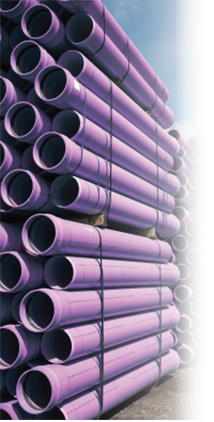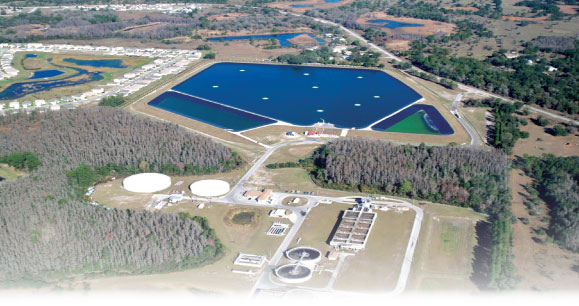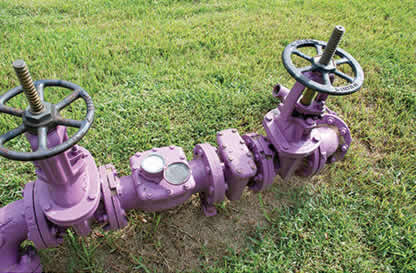Reuse of Wastewater Is Vital to the Region’s Future

Reduce, reuse and recycle — the three R’s of reducing waste — is a phrase that traditionally applies to the trash we throw away. But a District program takes the idea of reuse and applies it to one of our most precious resources: water.
The program is called water reuse: extending our water supply by using highly treated wastewater for irrigation and other uses.
Using this treated wastewater, called reclaimed water, helps reduce the demand for groundwater and surface water. This nontraditional water source reduces stress on environmental systems, provides economic benefits by delaying costly water system expansions, and eliminates the need to discharge wastewater effluent to surface waters.
“Reclaimed water is clear, it’s odorless — if anything, it has kind of a swimming pool smell because it has been disinfected with chlorine,” said Anthony Andrade, District project manager and senior water conservation analyst. “It’s a high-quality water source we can use in a lot of ways.”
Water reuse began in earnest in the late 1970s with the development of a landmark reclaimed water system for landscape irrigation in St. Petersburg. Most reclaimed water is still used for irrigation, but the District has continued to help utilities develop other uses for the water, including industrial applications and natural systems restoration.
The reuse of highly treated wastewater has multiple benefits, according to Andrade. First, reuse helps dispose of the treated wastewater.
“The idea of reusing wastewater started out as a way to solve the disposal problem,” said Andrade. “If you are not allowed to discharge into a surface water body, what are you going to do with the water? You’re either going to have to treat the water beyond drinking water standards and then dump it into the bay where it has no benefit, or you can reuse it for irrigation and other purposes.”
Another benefit of water reuse is that it can take the place of limited supplies of drinking water.
“The single largest use of drinking water is irrigation,” said Andrade. “In some areas, 30 to 50 percent of all drinking water is used for lawns. Reclaimed water can be used to meet irrigation needs. It’s a new water source that’s basically droughtproof, because there is always going to be wastewater.”
According to Andrade, reclaimed water is an economical alternative as well. Developing desalination and surface water sources can cost two to three times more than reclaimed water.
Using reclaimed water can reduce the demand for drinking water and delay the need to develop other sources of water supply. “Maybe even delay the need to develop those other sources indefinitely,” said Andrade.
Treated wastewater is reused throughout the District in many ways. The District and the Basin Boards have partnered with utilities to fund more than 300 reclaimed water projects over the past 25 years.

The 100-million-gallon Land O’ Lakes Reclaimed Water Reservoir will allow the utility to store reclaimed water during the rainy season and use it during the dry season.
Irrigation
“The vast majority of the reclaimed water use in our District goes to irrigation,” said Andrade. “Nearly half of all the golf courses in the District use reclaimed water for irrigation. That’s 200 golf courses. We have 476 parks and 151 schools using reclaimed water for irrigation — more than any other water management district in the state,” he said.

Top: Per capita water use in Pinellas County has fallen dramatically in the past 20 years, due in large part to the development of reclaimed water projects. Bottom: The use of reclaimed water has continued to grow and is projected to increase in the future.
In Manatee County, the District has helped fund a project that supplies 6,000 acres of agriculture with irrigation. The $37 million project provides 12 million gallons per day to irrigate citrus, row crops and one of the largest gladiola farms in the country. In Marion County, the On Top of the World development serves two golf courses with more than 200,000 gallons per day of reclaimed water.
“Utilities in Pinellas County have been leaders in reuse development,” said Andrade. “About 10 percent of all residents have access to reclaimed water, and 84 percent of the golf courses are using reclaimed water.”
Industrial
“Within the District, about 36 million of the 160 million gallons per day of reclaimed water used is for industrial purposes,” said Andrade. Industrial applications for reclaimed water include power generation and air conditioning systems for large buildings.
“The Home Shopping Network international headquarters in St. Petersburg has been using reclaimed water for 20 years,” he said. “All the cooling there uses reclaimed water. The Honeywell Aerospace Engineering facility in Clearwater and Tropicana Field use reclaimed water for air conditioning.”
Power plants use reclaimed water for cooling and for generating electricity, and eight power plants in the District are taking advantage of this resource. The largest reclaimed water project under way in the District is the Tampa Electric Company project in Polk County. Water from Lakeland, Polk County Utilities and the city of Mulberry will bring reclaimed water to the utility’s Polk Power Station. That project alone will eventually supply approximately seven million gallons per day of reclaimed water to the plant.
Restoration
Even the District’s mission of natural systems restoration can benefit from the use of reclaimed water.
“If you have an area that has lowered water levels or has had some alteration,” said Andrade, “you can use reclaimed water to restore that area to a more functioning wetland.” According to Andrade, this type of project would help recharge the aquifer, as well as restore wetlands.
“Recharge is happening all over the state,” said Andrade. “Just in our District, utilities are using 20 million gallons of reclaimed water a day to indirectly recharge the aquifer.”
The Future
“Using reclaimed water is a key component in meeting the water needs of the region,” said Andrade. “Right now we have 50 reclaimed water projects going from Citrus County to the north all the way down to Charlotte County. From one end of our District to the other — golf courses, power plants, agricultural projects and many residential irrigation projects. But we’re only halfway there.”

Reclaimed water piping systems are painted purple so they can be easily identified.
The District has continued to fund reclaimed water projects. The District budgeted more than $327 million in matching grants for 304 reclaimed water projects with more than 55 cooperators. This investment has leveraged projects that collectively will cost more than $807 million to construct and when complete will result in 875 miles of reclaimed water pipeline, 2.1 billion gallons of reclaimed water storage and 223 million gallons per day of reclaimed water supply. These reclaimed water projects will take the place of 151 million gallons per day of traditional water supplies that would have otherwise been used to meet demand. By 2030, reclaimed water use within the District is expected to approach 374 million gallons per day.

“There is enough reclaimed water pipeline in the District to stretch from Tampa to Washington, D.C.,” said Andrade. “Utilities within the District have more reuse than eight of the top 10 reuse states in the country combined. The District has done an excellent job, probably better than any other region in the country.”
In Pinellas County, 16 of the county’s 17 wastewater treatment plants provide reclaimed water. Districtwide, nearly 70 percent of these plants provide some level of water reuse.
“Pinellas County has reduced the amount of water used per person each day — what we call the per capita rate — by 43 percent over the past 20 years,” said Andrade. “Reclaimed water has been a major factor in the Pinellas per capita rate going from 153 gallons per day to 89. As utilities bring more reclaimed water customers online, we will see our per capita rate go down dramatically throughout the District.”
About half of all wastewater is reused Districtwide. “Half of it is disposed of,” said Andrade. “We need to find ways to partner with utilities so they can store more unused reclaimed water during the rainy season when the need for irrigation is low, and then have it available in the dry season. Aquifer storage and recovery projects are one of the innovative storage options. We also need to encourage utilities to do more metering of reclaimed water use and develop appropriate rate structures. And as more projects are developed, reclaimed water will help ensure that there is enough water for Florida’s future.”
